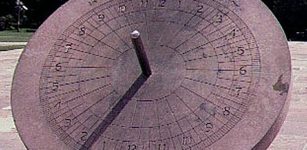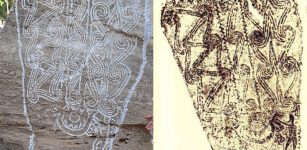Mysterious Clay Tablet Reveals Babylonians Used Trigonometry 1,000 Years Before Pythagoras
AncientPages.com - Plimpton 322 is a 3,700-year-old Babylonian clay tablets that has puzzled mathematicians for more than 70 years.
The small tablet was discovered in the early 1900s in what is now southern Iraq and many attempts were made to understand its purpose.
Now researchers have finally solved the mystery of this ancient clay tablet and the truth can be told.
Left: God Marduk of Babylon - Right: The 3,700-year-old Babylonian tablet Plimpton 322 at the Rare Book and Manuscript Library at Columbia University in New York. Credit: UNSW/Andrew Kelly
The new research presented by scientists from the University of New South Wales shows that the 3,700-year-old Babylonian artifact not only contains the world's oldest trigonometric table, but it’s also the only completely accurate trigonometric table, because of the very different Babylonian approach to arithmetic and geometry
This means that Babylonians beat the Greeks to the invention of trigonometry - the study of triangles - by more than 1,000 years.
The tablet is roughly the size of a cell phone. It has four columns and 15 rows of numbers written on it in the cuneiform script of the time using a base 60, or sexagesimal, system.
"Plimpton 322 has puzzled mathematicians for more than 70 years, since it was realized it contains a special pattern of numbers called Pythagorean triples," Dr Daniel Mansfield of the School of Mathematics and Statistics in the UNSW Faculty of Science said.
See also:
Cuneiform Tablets: One Of The Earliest Systems Of Writing Invented By The Sumerians
Intriguing Sumerian Clay Tokens – An Ancient ‘Book Keeping’ System Used Long After Writing Appeared
Babylonians And Sumerians Had Advanced Knowledge Of Astronomy
"The huge mystery, until now, was its purpose - why the ancient scribes carried out the complex task of generating and sorting the numbers on the tablet.
"Our research reveals that Plimpton 322 describes the shapes of right-angle triangles using a novel kind of trigonometry based on ratios, not angles and circles. It is a fascinating mathematical work that demonstrates undoubted genius.
The Plimpton 322 tablet.
Scientists are very impressed with this very old tablet because it’s a rare example of the ancient world teaching us something new. Plimpton 322 has great relevance for our modern world. Babylonian mathematics may have been out of fashion for more than 3000 years, but it has possible practical applications in surveying, computer graphics and education.
"A treasure-trove of Babylonian tablets exists, but only a fraction of them have been studied yet. The mathematical world is only waking up to the fact that this ancient but very sophisticated mathematical culture has much to teach us," Dr Wildberger said.
Plimpton 322 offers evidence the Babylonians, not the Greeks, were the pioneers of trigonometry.
AncientPages.com
Expand for references





















